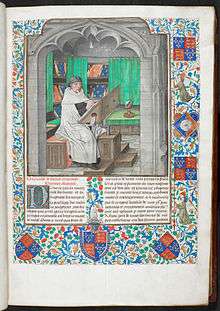Speculum literature

The medieval genre of speculum literature, popular from the twelfth through the sixteenth centuries, was inspired by the urge to encompass encyclopedic knowledge within a single work. The modern equivalent is a summary survey, in the sense of a survey article in a scholarly journal that summarizes a field of research. The speculum image, of the mirror that reflects far and wide, was drawn from the magical mirror that was supposed to belong among the treasures of legendary Prester John somewhere in the East; through it every province could be seen:
"Before our palace stands a mirror, the ascent to which consists of five and twenty steps of porpyry and serpentine ... This mirror is guarded day and night by three thousand men. We look therein and behold all that is taking place in every province and region subject to our sceptre."[1]
In the genre "Speculum of Princes", the prince's realms were surveyed and his duties laid out. Other specula offered mirrors of history, doctrine, or morals.
A number of medieval book titles include the word speculum:
- Speculum alchimiae, the "Mirror of Alchemy", written by Roger Bacon.
- Speculum astronomiae, written by Albertus Magnus.
- Speculum ecclesiae, the "Mirror of the Church", written by Edmund Rich.
- Speculum historiale, part of Speculum Maius the "Great Mirror" written by Vincent of Beauvais.
- Speculum Humanae Salvationis, the "Mirror of human salvation", written c. 1309-24, perhaps by Ludolph of Saxony.
- Speculum judiciale, or Speculum iuris, the "Mirror for Judges", written by Guillaume Durand.
- Speculum meditantis, the "Mirror of Meditations", written by John Gower.
- Speculum perfectionis, written by Brother Leo.
- Speculum stultorum, the "Mirror of Fools" written by Nigel de Longchamps
- Speculum regale, the "Mirror of Kings", which contains instructions for a young prince.
Ormulum, written by a certain Orm in Central England, bears an indirect reference to speculum and may be translated as "Orm's Mirror". It is universal in contents in that it contains the appropriate homiletic materials throughout the Church calendar.
In English mirror appears in, among many other works, the Myrrour of the Worlde (1490), one of the first illustrated books printed in English, by William Caxton (a translation of L'image du Monde, an overview of the sciences), the perennially-republished A Mirror for Magistrates (1559), and The Miroir or Glasse of the Synneful Soul, a manuscript translation from the French by the young Queen Elizabeth I of England. The Mirror of Simple Souls is a modern English translation of a similar French work. The word 'speculum' was rendered into English as 'mirror or glass'.
The Speculum Romanae Magnificentiae, Mirror of the Magnificence of Rome was a Renaissance "coffee table book" of prints of the sights of Rome, especially the antiquities, produced by the French print seller and publisher Antonio Lafreri (or Antoine du Pérac Lafréry, 1512-77). He had been publishing and distributing such prints, and selling them at his shop in Rome, since the 1540s. In the 1570s he hit on the idea of producing a title page for the albums of prints he also sold. Each copy of the Speculum may have different contents, as the customer in Rome could make his own selection in the shop & have them bound up.[2]
Similarly, the journal Speculum, published by the Medieval Academy of America, covers every aspect of the medieval world.
See also
Notes
- ↑ The fabricated "Letter of Prester John", said to have been sent to Manuel I Komnenos in 1165.
- ↑ Speculum Romanae Magnificentiae website, University of Chicago Library
References
- Bradley, Ritamary "Backgrounds of the Title Speculum in Mediaeval Literature" Speculum 29.1 (January 1954), pp. 100-115.